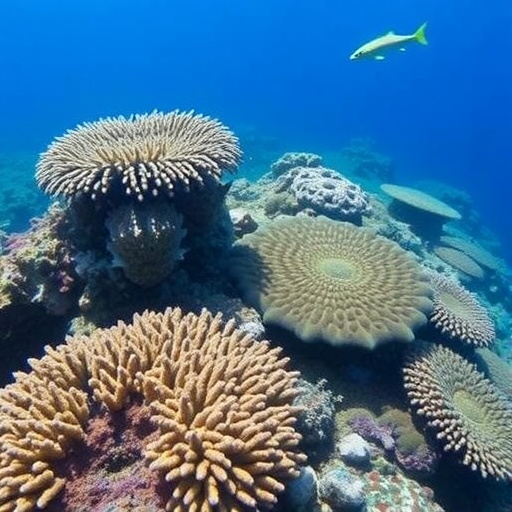As the world’s oceans steadily warm under the inexorable pressures of climate change, the fate of coral reefs—some of the planet’s most biologically diverse ecosystems—hangs in the balance. Recent scientific investigations are shedding new light on the resilience of certain coral species to sustained elevated temperatures, offering both a sobering and nuanced perspective on the future of these underwater rainforests. Among the corals under scrutiny is Stylophora pistillata, a species hailing from the northern Red Sea, renowned for its relatively high thermal tolerance. Yet, new experimental evidence suggests that even this hardiest coral cannot escape the physiological compromises forced by chronic warming.
In a controlled study conducted over six months, researchers meticulously simulated ocean temperatures projected for the mid- and late-21st century—27.5°C and 30°C—conditions that mirror anticipated increases globally due to greenhouse gas emissions. Stylophora pistillata exhibited an ability to survive these levels of heat stress for extended periods, marking a significant departure from the acute bleaching events that frequently decimate reef populations during anomalously warm spells. However, survival alone was not synonymous with thriving. Detailed measurements of coral growth revealed a stark reduction in calcification rates, with colonies exposed to 27.5°C exhibiting a 30% decrease in size compared to controls. The impact intensified at 30°C, where growth deficits soared to 70%, hinting at profound metabolic constraints beneath the surface.
Metabolic rate assessments pointed to an increased energetic cost for maintaining homeostasis in warmer waters. Elevated temperatures accelerate enzymatic reactions and cellular processes, yet they simultaneously increase respiratory demands, often leading to an energy deficit when photosynthetic symbionts cannot compensate adequately. This metabolic imbalance was evident in the dwindling energy reserves of Stylophora pistillata, presaging long-term declines in health and reproductive fitness. Importantly, the study underscored that the coral’s physiological responses were not static but evolved over time, with initial tolerance giving way to gradual deterioration as the chronic thermal exposure prolonged.
One of the more hopeful findings emerged during a subsequent recovery phase where corals were returned to a cooler, 25°C environment for a month. During this period, a notable physiological recuperation occurred, although survivors displayed a distinct dark pigmentation compared to never-heated counterparts. This hyperpigmentation is postulated to be an adaptive response potentially linked to protective mechanisms against light-induced stress or altered distribution of photosynthetic symbionts. Such phenotypic plasticity indicates that Stylophora pistillata harbors intrinsic mechanisms to rebound from sub-lethal thermal insults, a trait that may be critical as thermal variability increases with climate change.
Nonetheless, researchers caution against over-optimism. The projected warming of tropical seas by approximately 3°C by the year 2100 represents a relentless challenge to coral resilience. The study’s lead contributors emphasize that while survival is imperative, the compromised physiological state induced by chronic heat stress ultimately erodes the corals’ functional capacity. Over time, smaller colony sizes and reduced energy stores will likely translate into diminished reef complexity, financial repercussions for economies dependent on reef tourism and fisheries, and cascading effects on marine biodiversity.
Dr. Ann Marie Hulver, the study’s lead author and former Ohio State earth sciences scholar, highlighted that surviving merely scratches the surface of coral well-being. “Corals may persist under elevated temperatures, but their sub-lethal stress responses accumulate, potentially undermining reproduction, calcification, and overall reef stability,” she said. The long-term implications of such findings beckon advanced research into multifaceted biological trade-offs and the limits of coral acclimatization or adaptation.
Furthermore, the study reveals that the impact of thermal stress is cumulative and multifactorial. The first 11 weeks of temperature elevation had minimal visible effects, but it was the prolonged duration of exposure that precipitated metabolic strain and growth impairment. This temporal aspect is critical for understanding reef responses, as intermittent warming events may differ markedly from chronic baseline shifts anticipated in future oceans.
Co-author Andrea Grottoli, a professor specializing in earth sciences, underscored the urgency of integrating these nuanced physiological insights into conservation planning. She advocates for prioritizing protected sanctuaries where resilient coral populations such as Stylophora pistillata can continue to thrive and serve as biological reservoirs. This strategy hinges on identifying natural refuges—geographical locations characterized by favorable currents, shading, or cooler microhabitats—that can buffer corals against climate extremes.
The research team also recognized the need to extend their investigations beyond six-month experimental windows to encompass the full reproductive cycle and long-term ecological interactions influencing reef health. Corals’ life histories entail complex trade-offs, and understanding how sustained elevated temperatures affect not just survival and growth but reproductive output and offspring viability remains a critical frontier.
Moreover, the study’s transdisciplinary collaboration—encompassing expertise from Ohio State University, the Centre Scientifique de Monaco, and the University of Konstanz—exemplifies the global effort required to grapple with climate-driven coral declines. Funding provided by the National Science Foundation and the German Research Foundation enabled sophisticated experimental design and analyses, which integrate physiological, molecular, and ecological perspectives.
In conclusion, Stylophora pistillata provides a compelling, albeit cautionary, model of coral resilience under the shadow of climate change. Its ability to survive elevated temperatures comes tempered with diminished physiological function, chronic growth inhibition, and altered metabolic profiles. These findings present a more measured vision of coral futures, one that balances hope with the stark realities of ongoing ocean warming. As coral reefs continue to serve as vital pillars of marine ecosystems and human economies, ongoing research and targeted conservation efforts will be indispensable to preserving their complexity and biodiversity for generations to come.
Subject of Research: Thermal tolerance and physiological response of Stylophora pistillata coral under chronic elevated ocean temperatures
Article Title: Thermally resistant coral Stylophora pistillata survives but does not thrive under chronic elevated baseline temperature
News Publication Date: 3-Sep-2025
Web References: http://dx.doi.org/10.1016/j.scitotenv.2025.180234
References: Science of The Total Environment, Volume and article pending publication details as of September 2025
Keywords: Earth climate, Coral, Coral bleaching, Coral calcification, Reef building corals, Animals, Marine life, Zooplankton




